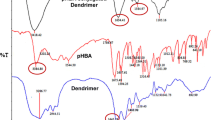Abstract
Didox (DX; 3,4-dihydroxy benzo-hydroxamic acid), a derivative of hydroxamic acid, is a potent inhibitor of ribonucleotide reductase (RR), the enzyme responsible for deoxyribonucleotide synthesis. While RR inhibitors such as hydroxyurea and others are being used widely for cancer treatment, DX is emerging as a newer RR inhibitor because of its lower rate of hematopoietic toxicity. DX also has an antiretroviral activity as it can deplete deoxynucleotides necessary for the synthesis of the pro-viral DNA intermediates of retrovirus replication. Our group is working on investigating application of DX for the treatment of glioblastoma (GBM). Since DX alone cannot cross the blood–brain barrier (BBB) (Veale et al. Br J Cancer 58:70–72, 1988; Dogruel et al. J Neurochem 87(1):76–84, 2003; Sébastien et al. Drug Metab Dispos 34:1945–1949, 2006), we propose use of dendrimers as a delivery system to improve its uptake by the brain. We investigated many different approaches such as using different PAMAM dendrimers (G4-amine, G4-Pyrr, hybrid dendrimers), changing the dendrimer and DX concentrations. Amine and PYRR dendrimers were of 4–5-nm size range and hybrid dendrimers were of 7–9-nm size range. Results indicated that dendrimers enhance the cell penetration capability of DX in GBM cell lines (2D and 3D). Effect of dendrimer was more prominent in 3D (neurospheres) compared with that in 2D cell lines. Pyrrolidinone (PYRR) PAMAM dendrimer formulations showed better biocompatibility compared with amine PAMAM dendrimers. We have also used the hybrid dendrimer approach to manage the safety of amine dendrimers. It was observed that carboxylate dendrimer significantly helped reduce amine dendrimer toxicity in hybrid dendrimer.











Similar content being viewed by others
Data availability
Material can be available on demand.
Abbreviations
- BBB:
-
Blood–brain barrier
- DAB:
-
Diaminobutane
- DX:
-
Didox
- GBM:
-
Glioblastoma
- HU:
-
Hydroxyurea
- LDLR:
-
Low-density lipoprotein receptor
- NPs:
-
Polyester-based nanoparticles
- PAMAM:
-
Polyamidoamine
- PPI:
-
Polypropyleneimine
- PTX:
-
Paclitaxel
- RR:
-
Ribonucleotide reductase
References
Agrawal U, Chashoo G, Sharma PR, Kumar A, Saxena AK, Vyas SP (2015) Tailored polymer-lipid hybrid nanoparticles for the delivery of drug conjugate: dual strategy for brain targeting. Colloids Surf B Biointerfaces 126:414–425. https://doi.org/10.1016/j.colsurfb.2014.12.045
Aye Y, Li M, Long MJ, Weiss RS (2014) Ribonucleotide reductase and cancer: biological mechanisms and targeted therapies. Oncogene 34:2011–2021
Chauhan AS (2015) Dendrimer nanotechnology for enhanced formulation and controlled delivery of resveratrol. Ann N Y Acad Sci 1348(1):134–140. https://doi.org/10.1111/nyas.12816
Chauhan A, Svenson S (2007) Formulations containing hybrid dendrimers. PCT_WO2007149500A9
Chauhan AS, Sridevi S, Chalasani KB, Jain AK, Jain SK, Jain NK, Diwan PV (2003) Dendrimer-mediated transdermal delivery: enhanced bioavailability of indomethacin. J Control Release 90(2003):335–343
Chauhan AS, Jain NK, Diwan PV (2004) Solubility enhancement of indomethacin using dendrimer complex and bio-disposition profile of these complexes in arthritic rats. J Drug Target 12(9–10):575–583
Chauhan A, Svenson S, Reyna L, Tomalia D (2007a) Solubility enhancement propensity of PAMAM nanoconstructs. Mater Matters Nanomater 2:24–26
Chauhan AS, Svenson S, Reyna L, Tomalia DA (2007b) Solubility enhancement of poorly water soluble molecules using dendrimers. Dendritic Nanotechnologies, Inc. Sigma Aldrich
Chitambar CR, Al-Gizawiy MM, Alhajala HS, Pechman KR, Wereley JP, Wujek R et al (2018) Gallium maltolate disrupts tumor iron metabolism and retards the growth of glioblastoma by inhibiting mitochondrial function and ribonucleotide reductase. Mol Cancer Ther 17:1240–1250
Clark PA, Iida M, Treisman DM, Kalluri H, Ezhilan S, Zorniak M et al (2012) Activation of multiple ERBB family receptors mediates glioblastoma cancer stem-like cell resistance to EGFR-targeted inhibition. Neoplasia 14:420–428
Di Mauro PP, Cascante A, Brugada Vilà P, Gómez-Vallejo V, Llop J, Borrós S (2018) Peptide-functionalized and high drug loaded novel nanoparticles as dual-targeting drug delivery system for modulated and controlled release of paclitaxel to brain glioma. Int J Pharm 553(1–2):169–185. https://doi.org/10.1016/j.ijpharm.2018.10.022
Kaynak EO, Qutub AA, Celiktas OY (2011) Advances in glioblastoma multiforme Kulhari H, Pooja D, Prajapati S, Chauhan AS. Performance evaluation of PAMAM dendrimer-based simvastatin formulations. Int J Pharm, 405 (1–2), 203–209. https://doi.org/10.1016/j.ijpharm.2010.12.002
Kulhari H, Pooja D, Prajapati S, Chauhan AS (2011) Performance evaluation of PAMAM dendrimer-based simvastatin formulations. Int J Pharm 405(1-2):203–209 https://doi.org/10.1016/j.ijpharm.2010.12.002.
Ostrom QT, Gittleman H, Liao P, Vecchione-Koval T, Wolinsky Y, Kruchko C et al (2017) CBTRUS Statistical Report: primary brain and other central nervous system tumors diagnosed in the United States in 2010-2014. Neuro Oncol 19:v1–v88
Singh MK, Kuncha M, Nayak VL, Sarma AVS, Kumar MJM, Chauhan AS, Sistla R (2019) An innovative in situ method of creating hybrid dendrimer nano-assembly: an efficient next generation dendritic platform for drug delivery. Nanomedicine 21 https://doi.org/10.1016/j.nano.2019.102043.
Sun H, Yang B, Zhang H, Song J, Zhang Y, Xing J et al (2019) RRM2 is a potential prognostic biomarker with functional significance in glioma. Int J Biol Sci 15:533–543
Tekade RK, Tekade M, Kumar M, Chauhan AS (2014) Dendrimer-stabilized smart-nanoparticle (DSSN) platform for targeted delivery of hydrophobic antitumor therapeutics. Pharm Res. 32(3):910–928. https://doi.org/10.1007/s11095-014-1506-0
Zorniak M, Clark PA, Leeper HE, Tipping MD, Francis DM, Kozak KR et al (2012) Differential expression of 2′,3′-cyclic-nucleotide 3′-phosphodiesterase and neural lineage markers correlate with glioblastoma xenograft infiltration and patient survival. Clin Cancer Res 18:3628–3636
Acknowledgments
The authors thank the Medical College of Wisconsin and Concordia University Wisconsin for continued support.
Author information
Authors and Affiliations
Contributions
All the authors contributed either in idea, research planning, or laboratory work.
Corresponding authors
Ethics declarations
Competing interests
The authors declare that they have no conflicts of interest.
Additional information
Publisher’s note
Springer Nature remains neutral with regard to jurisdictional claims in published maps and institutional affiliations.
Rights and permissions
About this article
Cite this article
Kaul, M., Alhajala, H., Chitambar, C.R. et al. Dendrimer–didox nanocomplex for enhanced anticancer activity. J Nanopart Res 22, 91 (2020). https://doi.org/10.1007/s11051-020-04802-0
Received:
Accepted:
Published:
DOI: https://doi.org/10.1007/s11051-020-04802-0




